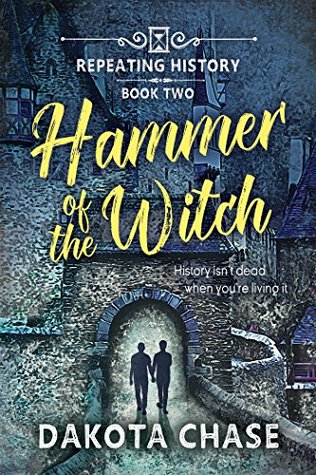Dakota Chase continues her young adult series, Repeating History, with Hammer of the Witch, returning to a contemporary world featuring magical, time-traveling shenanigans surrounding two teenagers.
To recap: In the first novel, The Eye of Ra, we met up with Aston and Grant at an unfortunate time in their lives. After a visit to juvenile court both boys are sentenced to a year at the Stanton Boys School, where their shenanigans intertwine after an incident in their history teacher’s office (which they manage to set fire to, destroying several priceless artifacts housed within). And it just so happens that their history teacher is the esteemed wizard Merlin. He-who-ran-with-King-Arthur, Merlin. Why the man would want to teach high schoolers is beyond me, but maybe he enjoys it. Aston and Grant have never been in this much trouble before, but an unlikely solution is found when they are tasked with going back in time and retrieving some of these artifacts for Merlin. In the first book Aston and Grant traveled back to Ancient Egypt in the times of King Tut, but the second book sends them back to medieval Europe, in the midst of the witch hunts.

Medieval Europe isn’t a pleasant place to be, and Aston and Grant find themselves in the midst of a hairy situation. The artifact they are after is the Malleus Maleficarum, a book used to persecute and kill innocents in the name of rooting out witchcraft. It isn’t an easy task to retrieve one of the bloodiest books in history, and along the way they meet friendly farmers, a pious and cruel priest, and an unsavory Baron — all while trying their best to avoid being accused of witchcraft themselves.
Aston and Grant are in the developing stages of a young romance, which makes for a sweet backdrop to their task. As teenagers they are equally as likely to punch one another as they are to kiss, and their emotions are written clearly on each page. Chase’s style tends towards emotive and highly descriptive, which is always a plus in fiction that is written from the perspective of teenagers. But no matter how sweet, Aston and Grant’s relationship reads as a pleasant backdrop for an unpleasant setting.
At just 180 pages, there’s not a lot of room for worldbuilding. The first book had a bit more setup for the setting at the school itself, and for various places in Egypt, but this one keeps itself contained in a single town and its outskirts, and doesn’t describe as much as might have been needed. The town itself is dreary and dark, and there isn’t much to redeem its residents either. They are made out as a shifty and mostly untrustworthy lot, and are generally as unpleasant as the town they reside in. There is a bit more main-character development to make up for the woeful setting, but it’s not a whole lot. Aston and Grant are teenagers, after all, and their growth as characters mostly consists of dealing with situations that are well over their heads, including the graphic experience (and descriptions) of the smell of witches burned at the stake and leading a small rebellion. Just an average day for your average teenager.
Overall, Chase’s merging of historical fantasy and modern perspectives is interesting, especially when it’s mixed with protagonists who don’t have all the facts. The premise of the books focus on the two embarking on something resembling a hands-on learning experience, some sort of intense field placement if you will, that teaches them about the underbelly of history that books don’t necessarily talk about. There is some debate between Aston and Grant as to whether or not their actions in the past will affect the past in any meaningful way, and this adds an element of hope to a book that takes place in a dark time.
However, as much as I like the plot of these books, I have to acknowledge that it’s a tad unrealistic and uncomfortable. Aston and Grant are forced to agree to helping Merlin, lest they are sent to juvie, and this is an extremely questionable resolution to their crime. Merlin’s task places them directly in the path of possible personal injury or death, and it’s a bad dynamic to put in what is otherwise a daring adventure in the past. It’s hard to imagine that Merlin would let two young boys come to much harm, but it’s the reality of this series that he forces them into life-threatening danger, and it’s hard to see someone in a teacher position — a position where we’d generally see a more protective attitude — place their young students in such precarious positions. It’s not the best look for a young adult novel, and affected my own perception of the novel, but I also understand that it’s a fundamental premise of the series.
Hammer of the Witch is sweet if you focus solely on Aston and Grant’s (mis)adventures as they stumble through improbable historical situations, but if you look deeper at the motivations behind their time-traveling, it takes on a darker tone. If you’re looking for an interesting meld of historical fantasy and modern teenagers, this series is something I’d probably recommend, but it would come with some reservations.
Dakota Chase
Published January 9, 2018







